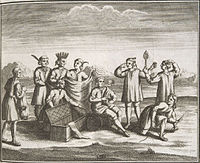Portal:North America/Selected article/18
The economy of the Iroquois originally focused on communal production and combined elements of both horticulture and hunter-gatherer systems. The tribes of the Iroquois Confederacy and other Northern Iroquoian-speaking peoples, including the Huron, lived in the region including what is now New York State and the Great Lakes area. The Iroquois Confederacy was composed of five different tribes — a sixth was added later — who had banded together shortly before European contact. While not Iroquois, the Huron peoples fell into the same linguistic group and shared an economy similar to the Iroquois. The Iroquois peoples were predominantly agricultural, harvesting the "Three Sisters" commonly grown by Native American groups: maize, beans, and squash. They developed certain cultural customs related to their lifestyle. Among these developments were ideas concerning the nature and management of property.
The Iroquois developed a system of economics very different from the now dominant Western variety. This system was characterized by such components as communal land ownership, division of labor by gender, and trade mostly based on gift economics. Contact with Europeans in the early 1600s had a profound impact on the economy of the Iroquois. At first, they became important trading partners, but the expansion of European settlement upset the balance of the Iroquois economy.

